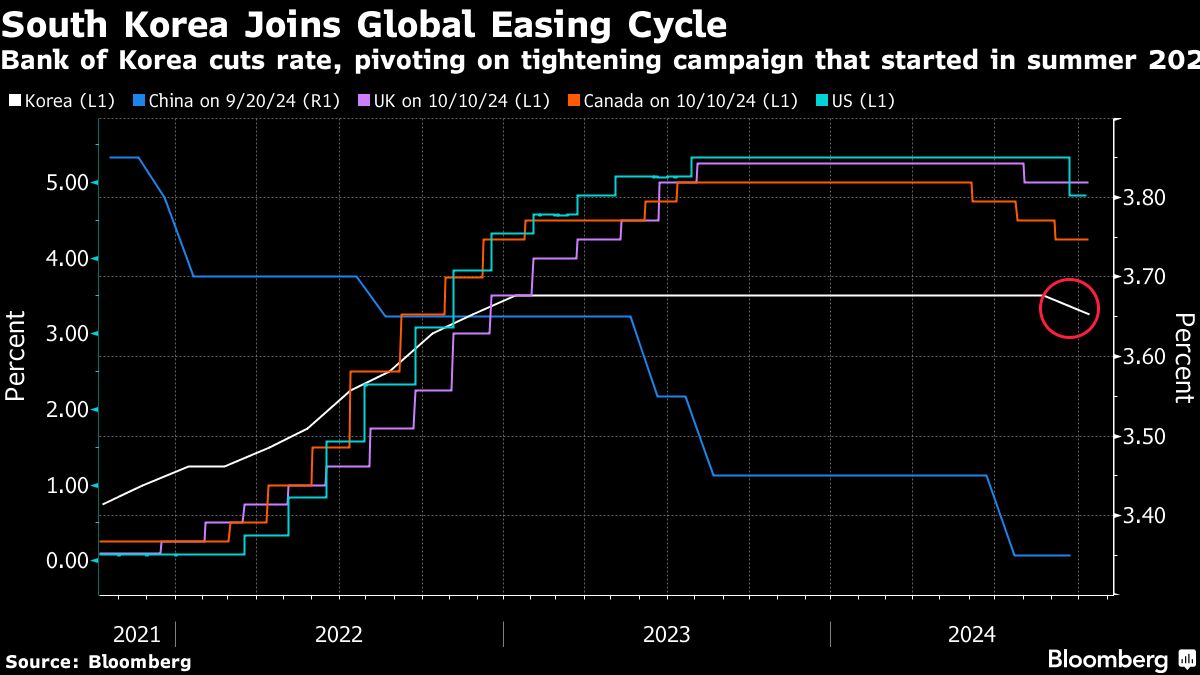
(Oct 11): The Bank of Korea (BOK) cautiously joined a global wave of central banks cutting rates, as it finally saw enough cooling of inflation and property prices to shift its attention to supporting the economy.
The South Korean central bank lowered its seven-day repurchase rate by a quarter-percentage-point to 3.25% in a decision predicted by 20 of 22 economists surveyed by Bloomberg.
Five members of the board see the rate staying there over the next three months, according to governor Changyong Rhee, a view that largely wipes out the likelihood of a follow-up rate cut next month, and pours cold water on expectations for a move in January. One member opposed Friday’s rate cut decision, another factor that suggests the bank will stand pat next month.
Rhee, speaking at a post-decision briefing, acknowledged the decision was essentially a “hawkish cut”. The currency market also reflected that view, with the won strengthening against the dollar, as traders recalibrated their expectations for the pace of easing. Bond yields edged down a tad, but would likely have moved more with a clearer sign of an imminent follow-up in the pipeline.
“It is safe to say there are no more cuts coming this year,” said An Young-jin, an economist at SK Securities. “But what’s clear is Rhee’s tone has shifted. He has sent a message that while the easing cycle has begun, markets need to manage their expectations for the pace of it.”
Before the decision, surveyed economists had essentially forecast two more rate cuts by the end of June next year. An said it is now harder to predict the level that the rate will reach by mid-2025.
With its policy pivot, the BOK joins a slew of central banks changing course to embark on easing cycles, in a bid to revive economic momentum after a weakening of inflationary pressure. The US Federal Reserve (Fed) last month cut its key rate by a half-percentage point as ensuring a soft landing for the economy took precedence over its inflation battle. That larger-than-regular move provided more scope to central bankers in other economies to consider nudging rates down too, without hammering their currencies.
“The rate cut not only responds to the consumption that’s been lacklustre, but also shows the BOK can afford to loosen a bit given the pressure pushing the inflation rate back above 2% appears limited,” said Ahn Yea-ha, an analyst at Kiwoom Securities Co.
Until Friday, the BOK had held the rate at a restrictive 3.5% for more than a year and a half. Policymakers extended the holding pattern in recent months on concerns that any early signals of a pivot might further fuel a rebound in the housing market and threaten financial stability.
The bank cited a “clear trend of stabilisation” in inflation, a slowing in the growth of household debt and an easing of currency risks as factors behind its decision, according to a statement. While the BOK said it was slightly moderating its restrictive stance, it removed a reference to keeping policy restrictive in its concluding remarks. The bank said it would judge the pace of further rate cuts by assessing prices, economic growth and financial stability.
“The biggest reason for the cut is that there is no need to keep the benchmark rate at a restrictive level for unnecessarily long,” Rhee said. “The pace of easing will be determined as we monitor financial stability.”
The rate cut reflects concerns over stagnant private spending and credit risks related to the construction industry. With most borrowers on floating rates, interest expenses have exerted a drag on consumption, prompting some lawmakers to call for the central bank to cut rates.
Still, Rhee warned against speculation for more easing in November, saying the members who voted for a cut on Friday want to monitor its impact on household debt and property prices before the next meeting. Rhee also talked down the possibility of a bigger-than-usual cut when the BOK eventually makes its next move. While the Fed went big in September, it was dealing with much stronger inflationary pressure and had higher rates than the BOK, he said.
The government has sought to rein in housing markets, with a pledge to increase home supplies and by rolling out stronger regulations on mortgage loans, moves that may have reassured the central bank that the market would cool. One BOK board member cited those measures in the lead-up to Friday’s decision, and Rhee also hailed the efforts at this briefing.
While the economy has largely kept expanding since the start of South Korea’s post-pandemic tightening cycle, and is on course this year to post growth of around 2.4%, recent figures offer a flattering view of growth.
Looking under the hood of the economy, spending by households has largely been flatlining over the last couple of years. While exports typically contribute more to South Korea’s growth than domestic consumption, the economy has relied far more on semiconductor-fuelled shipments abroad in the last couple of years than previously.
Once overseas demand starts to cool, the economy may start to look a lot less robust, as it tries to lean on that domestic demand for momentum. Spending by households in the second quarter fell 0.3% from the previous three months.
“Domestic consumer spending is by no means solid,” Rhee said.
Uploaded by Tham Yek Lee

